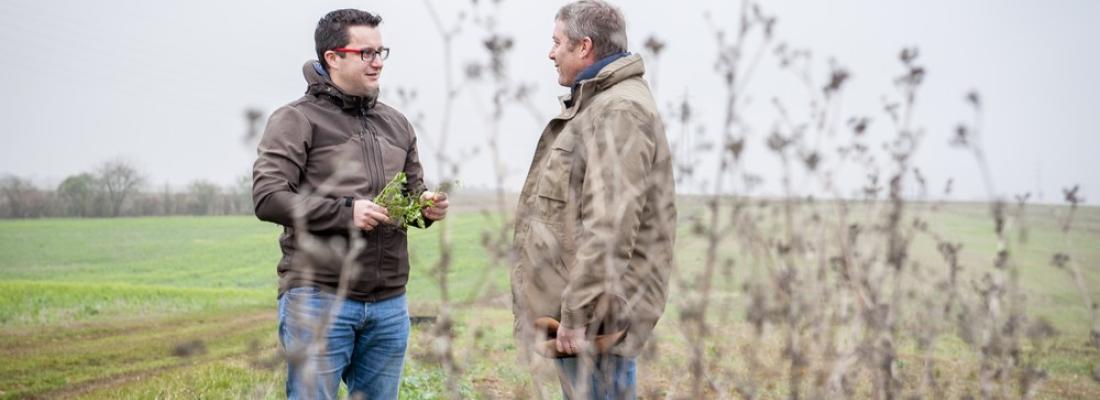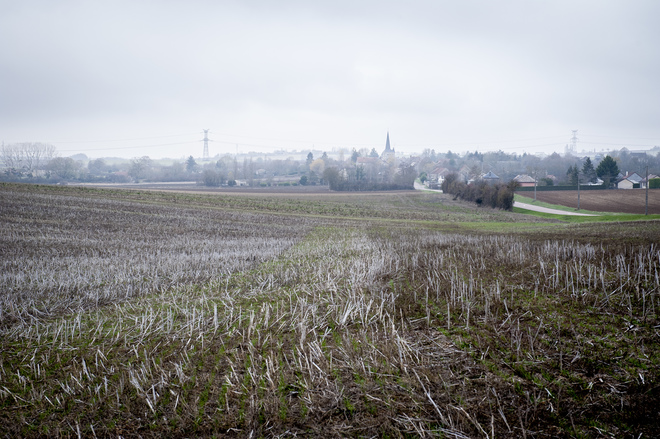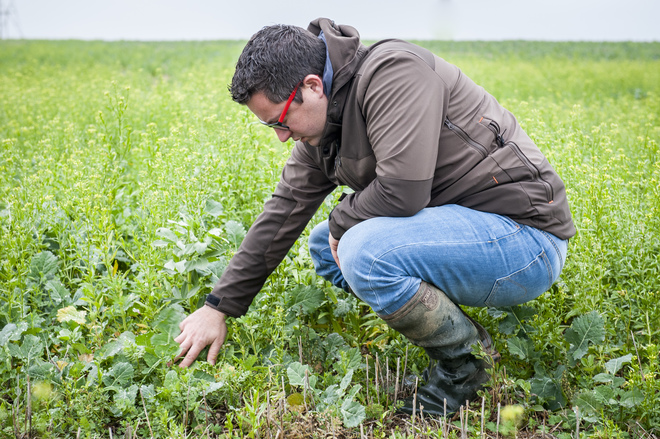Agroecology Reading time 5 min
A pioneer in soil conservation agriculture: a taste for innovation
Published on 22 January 2019

Four years after his conversion to soil conservation agriculture (SCA), Thierry Beauvais can be proud of his results: "This year, I have had the same yields as my neighbours and they are starting to take interest in my system, which initially had a somewhat negative reputation”. Today, Thierry works alone to manage his 360-hectare farm at Pougny, in the Nièvre region (58) using an apparently simple system: he does not till the soil and always sows his crops directly in permanent plant cover (NB. video filmed in November; fictitious images of sowing to illustrate operation of the drill).
A radical conversion
It was in 2015 that Thierry decided to purchase his direct seed drill, which is a crucial component in the system. Within three weeks, he converted his entire farm to SCA. “Before that, I was using a low-till system and a three-year rotation (wheat-barley-rapeseed). Under that system, regular surface tillage and a stale seedbed were necessary (1), which consumed a lot of fuel. The state of the fields continued to deteriorate, with a loss of organic matter, uncontrolled weeds due to their habituation and a yield plateau despite the use of fertilisers”. Under SCA, Thierry has switched to a six-year rotation (with soft or durum wheat, barley, rapeseed, sunflower, maize or sorghum) and has considerably reduced his use of inputs. The main problem encountered with a no-till system is the management of weeds, the seeds of which are no longer buried in the soil by tilling; however, the permanent presence of living “covers” helps to control weed growth without preventing that of crops.
The art of introducing cover

Thierry has become an expert in the tricky management of covers, the composition of which is adjusted each year to take account of drilling dates, vegetative cycles and the root depths of each species. He uses legumes which enrich the soil in nitrogen: bird’s foot trefoil, fenugreek, lentil, field bean, vetch and also camelina, a brassica in the rapeseed family whose yellow flowers serve as a lure to attract aphids. Thierry is particularly fond of bird’s foot trefoil, a cover legume that reseeds itself and has deep roots, which is an advantage in drought conditions. “Drought has become the main problem in recent years, and this led me to increase the use of bird’s foot trefoil as a cover with sorghum and durum wheat as crops”.
A low-input agroecological system
Economical in terms of nitrate fertilisers, insecticides, fungicides and fuel, the SCA system is a low-input method based on the principles of agroecology: it mobilises natural regulation to control pests and favour soil fertility thanks to soil microflora and microfauna, and the use of legumes. Lower input levels preserve wild biodiversity, so that the entire system forms a virtuous circle. However, the occasional use of herbicide (1.5 to 3 litres glyphosate/ha/year) remains necessary in autumn to clean the plots before drilling and limit the use of other herbicides in the spring (2).
Farmer-researchers and scientists in the field…

In the same way as scientists, Thierry is developing his own bibliography – in this case on the internet – sharing with his peers, innovating and experimenting. Stéphane Cordeau, a research scientist in agroecology at INRAE in Dijon and grandson of a farmer, carries out "field research to the benefit of agriculture”. This scientist has been studying the evolution of weeds in SCA systems for several years: "Under conventional systems, you may find eight or nine weed species per plot, while with SCA you will find between twenty and fifty species, some of which are not a problem. Favouring a broad diversity of weeds is a good thing as it avoids the need to deal with a single dominant, and often uncontrollable, species”.
… working in direct and close collaboration
Stéphane meets with farmers on a regular basis (3). In response, Thierry and other farmers in his group, GIEE Magellan, have participated in INRAE workshops on the design of experimental systems (2). Thierry also makes his plots available to the scientists so that they can monitor the evolution of weeds and insects.
Thus the professions of agronomist and farmer are evolving, as are their relationships. With the current challenges faced by agriculture, it is in the field that they come together to develop innovative systems for the future.
(1) Surface tillage only affects the top layer of soil and is intended to bury residues and, in some cases, foster the germination of weed seeds (stale seedbed) so that they are destroyed before the crop is drilled.
(2) See insert 2 on the use of glyphosate.
(3) Meeting of GIEE Magellan, 9 November 2018.
In its strictest form, soil conservation agriculture is direct sowing under permanent plant cover, and is described as one of the systems that is dependent on glyphosate, although low doses are sufficient under certain conditions (see the article in French and INRAE report: “Uses of and alternatives to glyphosate in French agriculture”, published in November 2017).
So how can the SCA system be pursued after glyphosate is banned in 2020? Stéphane Cordeau thinks that “glyphosate will certainly be replaced by a major redesign of cropping systems, and not by simply using another agent instead of glyphosate. It will be necessary to operate a combination of agronomic levers, such as improvements to cover crops, extensions to rotations or alternating winter and spring crops in order to break the weed cycle. Technological advances in agriculture will help. For the moment, farmers who have applied SCA and tried to work without glyphosate had to return to soil tillage, even if this was very superficial. This is not an acceptable option for a large number of SCA farmers. Because this does not depend on financial results, research needs to test innovative or even risky solutions”.
Several experiments are being conducted by INRAE on SCA systems, working in collaboration with farmers:
- The CA-SYS platform: 120 ha managed without pesticides since 2018 (half drilled directly) covering the entire Epoisses Experimental Farm near Dijon (Contact: Stéphane Cordeau and Violaine Deytieux). See the article and the video.
- A project on monitoring weeds in several agroecological systems, in the context of the I-SITE project (French only) (Investments for the Future programme).
- A PhD thesis devoted to the evolution of weeds in a network of 80 plots farmed under SCA conditions (contacts: Damien Derrouch, Bruno Chauvel).
As for the farmers, they are also experimenting in their working groups, such as the GIEE Magellan to which Thierry Beauvais belongs. He explains: "We are going to test eight-year rotations with two or three hectares without glyphosate“.
